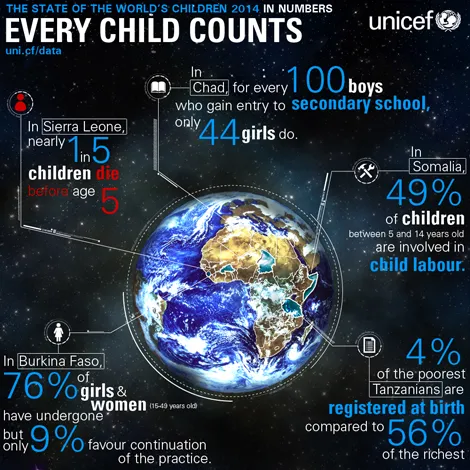State of the World's Children 2014 In Numbers
The world has made significant progress for child survival and children's rights. For example, fewer children now die before their fifth birthdays and more girls are in school than ever before. However, despite this progress, data show us that far too many children are left behind. This marginalization is hidden by statistical averages, which show overall improvement but mask disparities within nations. Children left behind become ‘invisible.’
Every child counts
UNICEF's report The State of the World's Children 2014 in Numbers highlights the importance of inclusive data in making progress for children and exposing unequal access to services and protections.
Data make change possible by providing evidence for action, investment and accountability towards key benchmarks like the Convention on the Rights of the Child and the Millennium Development Goals.
The Government of Canada, a global leader in maternal, newborn and child health, recognizes the importance of data for not only achieving children’s rights, but also holding governments accountable to their commitments to children. Canada’s commitment to civil registration brings attention to the vital need of ensuring that all children everywhere have an official identity, and are therefore counted. Reducing the disparities means focusing on the children who are hardest to reach – including those in Canada.
What the data shows
- Some 90 million children who would have died before reaching the age of 5 if child mortality rates had stuck at their 1990 level have, instead, lived. In large measure, this is because of progress in delivering immunizations, health, and water and sanitation services.
- Improvements in nutrition have led to a 37 per cent drop in stunting since 1990.
- Primary school enrolment has increased, even in the least developed countries: Whereas in 1990 only 53 in 100 children in those countries were in school, by 2011 the number had improved to 81 in 100.
The statistics also bear witness to ongoing violations of children's rights:
- Some 6.6 million children under 5 years of age died in 2012, mostly from preventable causes, in violation of their fundamental right to survive and develop.
- 15 per cent of the world’s children are put to work that compromises their right to protection from economic exploitation and infringes on their right to learn and play.
- 11 per cent of girls are married before they turn 15, jeopardizing their rights to health, education and protection.
Data also reveal gaps and inequities, showing the gains of development are unevenly distributed.

Learn More
Visit the global microsite for an interactive experience
See the Canadian Perspective
UNICEF Canada's David Morley offers insights for Canada
